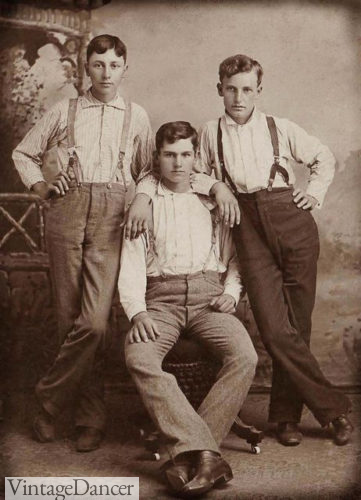A North London street 1950s. Hey guys Im a student at the royal academy of Fine Arts in Antwerp fashion section and for this years assignment we need to recreate an outfit from a picturepainting from before 1900.

Working Class Victorian Life Witness2fashion
Throughout the century service was a major employer of women.

. They worked either in factories or in domestic service for richer households or in family businesses. When history emerged as a scholarly discipline in British universities at the end of the 19th century it rarely took. Mar 25 2018 - Explore Amy Lieberts board Early 19th century work garments on Pinterest.
But how much did it cost to remain à la mode and who were the people who made these clothes. The fashion of the 19th century is renowned for its corsets bonnets top hats bustles and petticoats. The London omnibuses needed 16000 drivers and conductors by 1861.
Posted by 1 year ago. Short-fronted tailcoats and fitted waistcoats were worn over plain white linen shirts. In eighteenth-and early nineteenth-century Britain the red woolen hooded cloak was commonly worn by rural women.
Extravagant dandies led the fashion world. Posted by 7 months ago. Corsetry in the 19th century was not only fashionable but seemingly a trend women were expected to follow there were implications of lax morals if a woman chose not to wear a corset.
By the turn of the 19th century breeches pantaloons and trousers worn by all men were sewn with a flap in front called a fall front. Emma Griffin charts the postwar emergence of working-class history as a scholarly discipline and argues that thanks to the torch-bearers the rationale for it has ebbed away. Most working class women in Victorian England had no choice but to work in order to help support their families.
Pam Inder shares the stories of those who dressed the 19th. 1830s fashion was dramatic and overwhelming marked by huge sleeves and hats reflecting the Romantic movement. In the 19th-century women wore several layers of clothing and depending on their socioeconomic status the clothing got more complicated.
Women and work in the 19th century. Most servants were female. History of Fashion 1840 - 1900 - Victoria and Albert Museum We have launched a new website and are reviewing this page.
Working class fashion - Late 19th century Ireland. Working class fashion - Late 19th century Ireland. Waistcoats were always worn over a white shirt.
Working men wore vests of heavy cotton or denim. Womens fashion during the Victorian period was largely dominated by full skirts which gradually moved to the back of the silhouette. Today the working class is not looked on by society as something to aspire to be but the whole class did not exist largely before the 19th century and was instead a peasant class existed that performed labor for lords of the land.
What designers now do consciously and with great care our 19th century gentry and working class alike treated as part of everyday life. In order to be considered middle class you had to have at least one servant. Explore the history of fashion in the mid- to late-19th century decade by decade through garments and photographs in the VA collections.
At the eve of Industrial change throughout Europe London stood above the other powers. From a lot of lithographs previously sold at the Salcedo Auctions Important Philippine Art sale March 2018. The need for a corset could well have been supplanted by alternative styles of dress which did not require a corset although.
Tight-fitting pantaloons replaced eighteenth century knee breeches Hessian boots replaced buckled shoes and intricately tied white linen neck cloths became the mark of the true man of fashion. This flap was universally held in place by two or three buttons at the top. After 1836 the exuberance that had defined fashion since the 1820s collapsed into a drooping sentimentality.
A skilled London coach-maker could earn up to five guineas 5 five shillings a week considerably more than most middle class clerks. While clothing was determined by the days activities the basic underclothes or foundational layer for all outfits a chemise drawers stockings corset and petticoats remained fairly consistent. Upper class men wore silk or wool broadcloth vests.
Fashion circa 19th century Philippines a foretaste of styles to come. See more ideas about regency fashion regency dress historical clothing. Womens clothing accentuated and exaggerated the hips breasts and derriere not only to make the wearer seem more attractive but to separate these wealthy ladies from the world of work.
Cutaway Tail Coat 1805-1810. 19th Century Urban Working Class. In some situations working women were the.
It was at this time in the 19th century that womens clothes in the upper echelons of society came to be more sexualized. Working class fashion - Late 19th century Ireland. Feb 18 2022 - Explore Charles Winchesters board Working Class Dress of the Eighteenth Century on Pinterest.
See more ideas about 18th century 18 century art 18th century clothing. Women used boots instead of shoes. Working class fashion - Late 19th century Ireland.
On display will be dresses from the 1830s to 1860s and accessories worn with the outfits of the time said Fabiola Jean-Baptiste NGL marketing and events coordinator. Male servants were much more expensive because men were paid much higher wages. The common utilitarian dress for laboring men before the twentieth century was made up of breeches or trousers jackets and waistcoats of hard-wearing materials such as moleskin fustian or corduroy.
Pattens and then clogs were valuable assets for workingmen and -women on dirt roads and later in factories and mills. Women and work in the 19th century. August 4 2017.
However towards the end of the period the less restrictive Aesthetic style began to emerge. In class-conscious 19th-century society fashion was key as a way of demonstrating social position and wealth. This was the top of the working class pyramid.
In the late 19th century about 80 of the population of the population was working class. The railways generated employment for porters and cab-drivers. No belts were worn.
1830-1839 19th century decade overview. In the 19 th-century all women wore several layers of clothing though the clothing got more complicated depending on their socioeconomic status. Only the very poor or the very rich would dare stray from the dictates of the time.
Even laborers wore vests at work as appearing in only a shirt was considered inappropriate.

A Working Class Family Circa 1880 Victorian Life Class Outfit Victorian Clothing

1840 1849 Fashion History Timeline

Working Class Dress Lovetoknow

19th Century Fashion History Nineteenth Century 1800s 1840s 1850s Antebellum Victorian Victoriana Civil Wa Civil War Era Civil War Reenacting Civil War Fashion
Women S Fashion In The 19th Century Historic Hudson Valley

Working Class Fashion Late 19th Century Ireland R Historicalcostuming

0 comments
Post a Comment